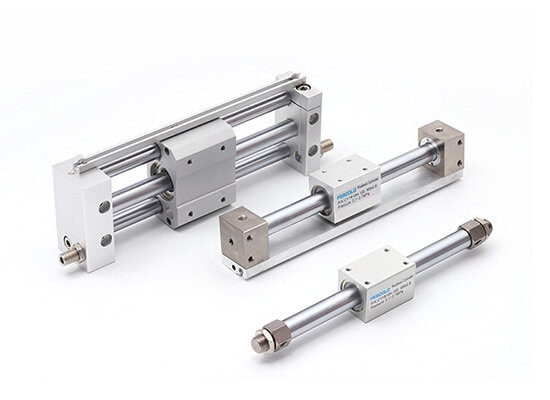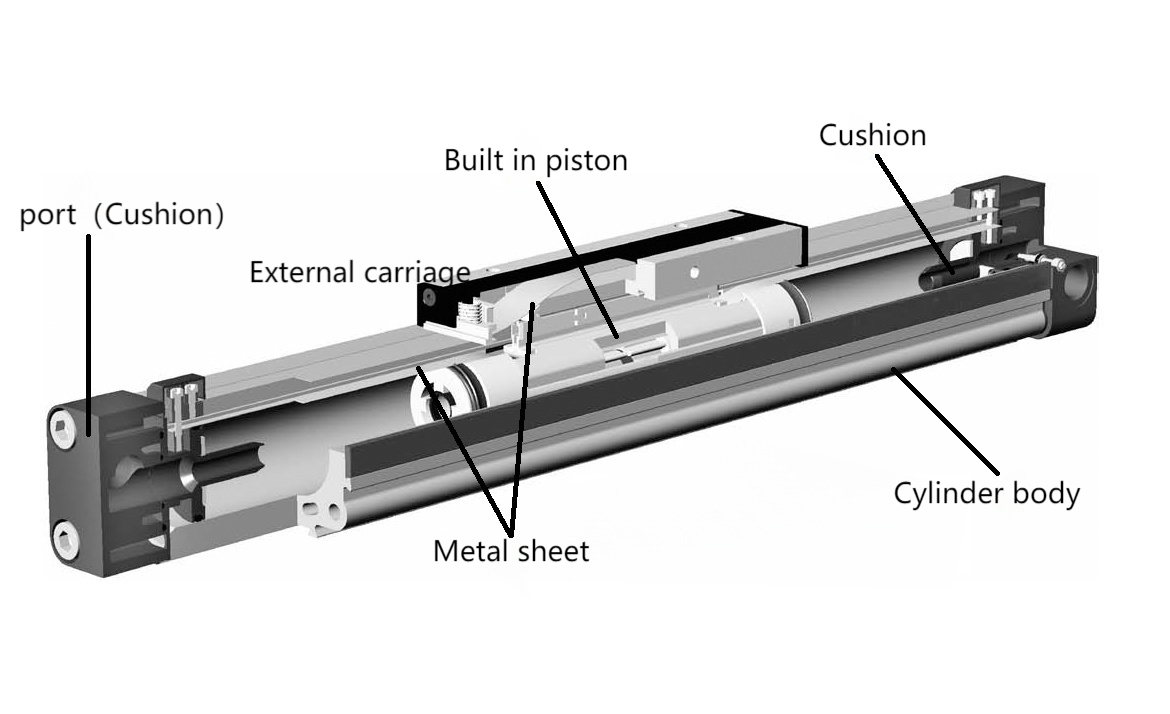
In the world of industrial automation and motion control, space is often at a premium. That's where the pneumatic rodless cylinder comes into play — a compact, efficient alternative to traditional rod-type cylinders.
Pneumatic rodless cylinders that can provide linear motion without the need for external piston rods. The internal piston moves in the direction of the cylinder through changes in air pressure inside the cylinder.Very practical for modern industrial automation and manufacturing systems that require long travel distances
Pneumatic rodless cylinder piston will be directly or indirectly connected to an external carriage and drive it move along the direction of the cylinder. This external carriage carries the load or object you need to move.
The twisting principle of a rod cylinder relies on the piston rod to transmit force, while a rodless cylinder transmits force through a magnetic coupling mechanism that connects an external load bearing slider and an internal piston.
We take the mechanically coupled pneumatic rodless cylinder as an example. Learn the specific working mode of rodless pneumatic cylinder.
A cylinder barrel
An internal piston
A slider that moves along the cylinder
A magnetic coupling mechanism
End caps and air ports
Sealing ring
Whether with or without rods, the prerequisite for cylinder operation is to maintain the sealing state of the cylinder, maintain air pressure, and prevent pollutants from entering.
The beginning of cylinder operation is usually initiated by the internal piston being subjected to air pressure. Differently, the internal piston of the rodless cylinder is connected to a magnetic coupling mechanism and moves in a straight line along the cylinder barrel
The movement of the piston is ultimately to drive the load or object to move, so the carriage outside the cylinder is the bridge connecting the two. How to install the carriage outside the cylinder? There are three ways to connect the piston and slide
Slot: There is a slot with a sealing ring on the cylinder to prevent air from escaping. The piston is connected to the carriage through this slot.
Magnet: Strong magnets on the piston and slide can pull the slide when the piston moves.
Cable: A cable that connects the inside of the piston and the outside of the carriage, and can pull the carriage when the piston moves.
The installed carriage will move with the movement of the internal piston in three ways, with the external carriage directly or indirectly connected to the internal piston.

Due to the rodless design, it can help users consider application industries with limited space more, as long travel and stability can greatly improve the efficiency of application industries.
Rod Type Cylinder: It pushes the load through the piston rod, with a simple structure but high rigidity and strong guidance, suitable for working conditions with high requirements for repeatability and stability. The total length is equal to the stroke+cylinder length+piston rod length, occupying a large amount of space.
Rodless Cylinder: No piston rod, requires additional guide rails or slider support, slightly lower accuracy. The piston drives the external connecting slider to move, and the entire load runs on the side cylinder with a long stroke. The stroke is basically the same as the length of the cylinder body, saving installation space and making it very suitable for automated equipment with limited space.
When using rodless cylinders, parameters such as temperature, pressure, and speed should be considered.
◆ Rodless cylinders with magnetic coupling have no piston rod protruding from the cylinder block.
◆ The overall installation size is small, and the axial space is small, which saves about 44% of the axial space than the standard regular cylinders.
◆ Magnetically coupled pneumatic rodless cylinder can produce ultra-long stroke.
◆ The magnetic coupling type has a small shape and has mounting threads and nuts at both ends, which can be directly installed on the equipment
Pneumatic rodless cylinders are not affected by rod overhang, bending, piston binding and uneven seal wear, rodless cylinders are ideal for applications in confined areas and long strokes where space is limited.
Linear transportation
Sliding table
Traverse Device
Pneumatic rodless cylinders are undoubtedly the best rodless cylinders for linear automation.
Fokca offers two types of pneumatic rodless cylinders, including magnetic rodless cylinders and magnetic coupled rodless cylinders.
magnetic rodless cylinders include Basic type: CY1B, CY3B, without guide structure and Imitation rotation type: CY1R imitation rotation with guiding base plate.
magnetic coupled rodless cylinders include Double rod type: CY1S and CY1L.
Five things to consider when choosing a rodless cylinder can help you use it more efficiently.
Piston stroke length: The distance that the cylinder moves forward and backward determines the length of piston movement. Please ensure that its length is sufficient to meet your needs.
Load bearing capacity: When choosing a rodless cylinder, you must consider the weight that the cylinder can bear.
Speed: Some rodless cylinders are faster than others, so please choose a cylinder that meets your speed requirements.
Installation options: Install the cylinder onto your machine or equipment. Different cylinders have different installation options, so please ensure that they are installed properly.
Space: The rodless cylinder does not require an extended rod, which can save space, so the space for cylinder movement can be considered.
Fokca is a leading cylinder manufacturer, specializing in the customization of various types of cylinders. With a wide range of cylinder options available, we are dedicated to providing tailored solutions to meet the specific needs of our customers.
Fokca rodless cylinders are designed for efficient, smooth, and long-lasting linear motion in a wide range of applications. Our rodless cylinders are often used in automation systems where space constraints or long stroke lengths are critical.
If you're interested in our products or require more information, please feel free to contact us for further details and specifications. We look forward to serving your pneumatic needs!
FOKCA ©1998-2025 Fescolo Pneumatic All Rights Reserved Sitemap